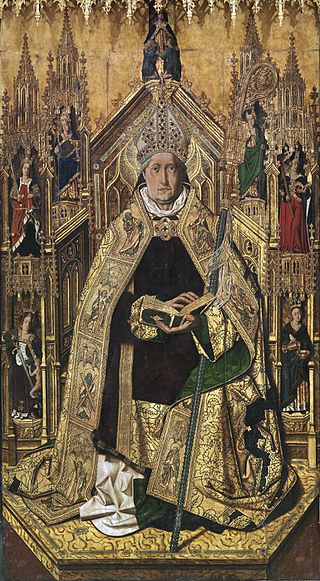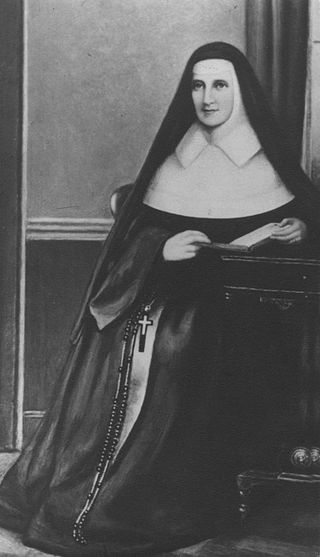
Abbot is an ecclesiastical title given to the male head of a monastery in various Western religious traditions, including Christianity. The office may also be given as an honorary title to a clergyman who is not the head of a monastery. The female equivalent is abbess.

The Sisters of Mercy is a religious institute of Catholic women founded in 1831 in Dublin, Ireland, by Catherine McAuley. As of 2019, the institute has about 6200 sisters worldwide, organized into a number of independent congregations. They also started many education and health care facilities around the world.

Augustinians are members of several religious orders that follow the Rule of Saint Augustine, written in about 400 AD by Augustine of Hippo. There are two distinct types of Augustinians in Catholic religious orders dating back to the 12th–13th centuries:

Camillus de Lellis, M.I., was a Roman Catholic priest from Italy who founded the Camillians, a religious order dedicated to the care of the sick. He was beatified by Pope Benedict XIV in the year 1742, and canonized by him four years later in 1746. De Lellis is the patron saint of the sick, hospitals, nurses and physicians. His assistance is also invoked against gambling.

Gerolamo Emiliani, CRS was an Italian humanitarian, founder of the Somaschi Fathers, and is considered a saint by the Catholic Church.

In the Catholic Church, a religious order is a community of consecrated life with members that profess solemn vows. They are classed as a type of religious institute.
The Franciscan Sisters of Christian Charity are a Congregation of Roman Catholic apostolic religious women. The congregation was founded in 1869 in Manitowoc, Wisconsin in the Roman Catholic Archdiocese of Milwaukee, later part of the Roman Catholic Diocese of Green Bay. The sisters have active apostolates in education, health care, spiritual direction, and other community ministries. As of 2021, there are 188 sisters in the community. The FSCC is a member of the Council of Major Superiors of Women Religious, an organization which represents women religious in the United States.
Canons regular are priests who live in community under a rule and are generally organised into religious orders, differing from both secular canons and other forms of religious life, such as clerics regular, designated by a partly similar terminology.

The Hospital Brothers of Saint Anthony, Order of Saint Anthony or Canons Regular of Saint Anthony of Vienne, also Antonines or Antonites, were a congregation in the Roman Catholic church, founded in c. 1095, with the purpose of caring for those suffering from the common medieval disease of Saint Anthony's fire. The mother abbey was the abbey of Saint-Antoine-l'Abbaye.
The Third Order of Saint Francis is a third order in the Franciscan tradition of Christianity, founded by the medieval Italian Catholic friar Francis of Assisi.
Independent Augustinian communities are Roman Catholic religious communities that follow the Augustinian Rule, but are not under the jurisdiction of the Prior General of the Augustinian hermits in Rome.

The Third Order of Saint Dominic, also referred to as the Lay Fraternities of Saint Dominic or Lay Dominicans since 1972, is a Catholic third order which is part of the Dominican Order.
St. Alexius Medical Center is a faith-based community hospital located in Hoffman Estates, Illinois, a northwest suburb of Chicago.
The Poor Brothers of the Seraphic St. Francis, abbreviated C.F.P. are a Catholic lay religious congregation of Pontifical Right for men of the Third Order Regular of St. Francis, instituted for charitable work among orphan boys and for youth education. They commonly also use the title of Brothers of the Poor of St. Francis.
John Bernard Kevenhoerster, O.S.B. was a German-born prelate of the Catholic Church. He served as the first Prefect Apostolic (1931–41) and Vicar Apostolic (1941-49) of the Bahama Islands.
The Sisters of Charity of St. Augustine, a Roman Catholic religious congregation of women, have served health, education and social service needs in the Diocese of Cleveland, Ohio, since 1851.

The Catholic Church is the largest non-government provider of health care services in the world. It has around 18,000 clinics, 16,000 homes for the elderly and those with special needs, and 5,500 hospitals, with 65 percent of them located in developing countries. In 2010, the Church's Pontifical Council for the Pastoral Care of Health Care Workers said that the Church manages 26% of the world's health care facilities. The Church's involvement in health care has ancient origins.

The Bethlehemite Brothers are a religious institute founded in Guatemala in 1653 and restored in 1984.












